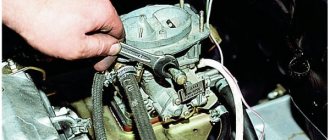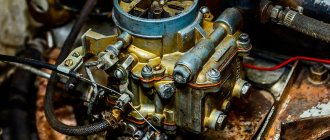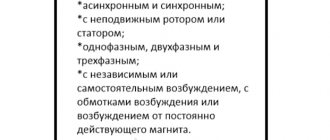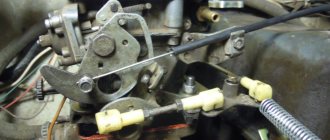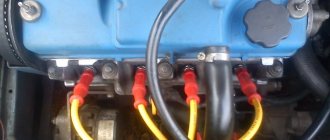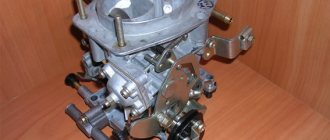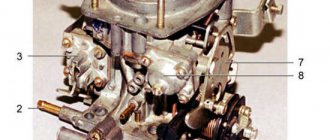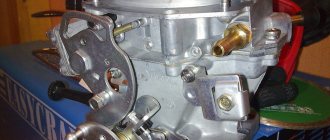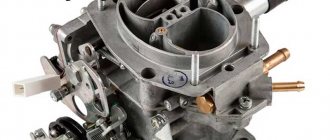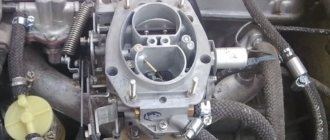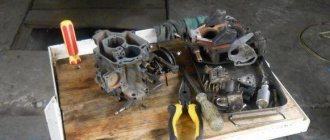Despite the widespread replacement of carburetor systems with injection systems, a huge number of engines of the old design are still running. Many classic VAZ models are equipped with Solex or DAAZ carburetors. To regulate motor power, depending on the load, so-called economizers are installed. These devices work in a similar way to electronic control units for injection engines. Of course, it will not be possible to achieve the same parameters of engine efficiency and environmental friendliness, but the quality of operation of a carburetor engine is significantly improved.
Essentially, any economizer is a valve that is actuated by an electromagnet or piezoelectric element. It is controlled by a simple programmable computer (more like a controller), and allows you to adjust basic settings. The purpose of the economizer comes from the name: to increase the efficiency of the power unit without losing power removed from the crankshaft.
Please note that it is impossible to install an economizer on a carburetor that is not intended for this purpose. The design of the chambers is specially designed to work with controlled valves.
The economizer system also requires periodic maintenance, like the rest of the carburetor valves and jets. To understand the mechanism of operation, we will analyze popular carburetors installed on classic and front-wheel drive VAZ models.
How does a carburetor work?
The following figure will help you understand its operating principle.
This is the simplest version of the carburetor, one can say that it only explains its structure and the main idea. Gasoline is in the float chamber at a constant level, which is maintained by the operation of the needle valve. Through the air filter, air is drawn into the engine cylinders. It passes through the mixing chamber, thanks to the narrowing there, in this place a vacuum is created in relation to the float chamber, in which the level of atmospheric pressure is maintained.
Due to the resulting pressure difference, fuel enters the mixing chamber. Passing through the nozzle, it breaks into small droplets, evaporates and mixes with air, resulting in the formation of a fuel assembly that enters the engine cylinders. The relationship between these components depends on the position of the carburetor damper, which is associated with the position of the accelerator pedal. The harder it is pressed on the car, the more the damper is open, the higher the degree of vacuum and the more gasoline is supplied to form the mixture.
Setting the float chamber level
This is the first step in adjusting any carburetor. It is on this part that the consumption and stability of the engine will depend.
The level must be at the nominal level set by the manufacturer, so it is very important to follow the technology
Setting the fuel level in the float chamber: I - carburetor cover; 2 — needle valve seat; 3 - emphasis; 4 - needle valve; 5 - locking needle ball; 6 - valve needle pull-out fork; 7 — float bracket; 8 - tongue; 9 — float; 10 - gasket.
The top cover of the carburetor is removed, but before that, you need to pump up the manual fuel pump to check the set level. The nominal level is the level of gasoline located on half of the inclined surface. If it is higher or lower, then adjust the float level by bending the adjusting antennae. The XX speed is also regulated by the float chamber.
To check, just put the cover on top, start the engine and immediately turn it off. Open the lid again and check the level. After this, you can move on to the next stage.
Purpose of the economizer
At the moment when the damper is almost completely open, the car engine experiences maximum loads, which means that to overcome them it requires a larger amount of gasoline than during normal operation. At the same time, the economizer begins to work, more fuel is supplied to form the mixture, and the mixture becomes enriched. Its purpose and structure, as well as why an economizer is needed, becomes clear from the figure:
The carburetor throttle valve is connected to a special valve through rods and levers. When it is completely open, this causes it to operate, and an additional amount of gasoline, passing through the economizer nozzle, goes to form the fuel assembly. This supply of fuel causes the mixture to become richer and ensures that the engine operates under increased load. When the gas pedal is released, the damper closes, the spring closes the valve and the economizer stops operating.
Structurally, the economizer device can be implemented in various ways; we will not touch on their specific implementation, because For the carburetor, after the advent of injection controllers, the development history ended.
Fuel clots are the cause of high consumption
The economizer works with “clumps” of fuel. Regardless of the brand, octane number, the fuel, while in the tank of the vehicle, is subject to the intensity of environmental parameters. For example, the structure of the fuel is significantly influenced by humidity or ambient temperature, which have a direct effect on the mixture, changing it. As a result, the fuel changes slightly, expands or contracts, but the end result is the same - the formation of clots. The formation of clots is caused by the mutual attraction of hydrocarbon molecules in the fuel, which are the basis of this mixture.
The formation of such clots is observed in a zone inaccessible to oxygen saturation; such fuel does not have the opportunity to burn completely when it passes into the engine. This leads to additional fuel consumption for the operation of the vehicle, taking into account that previously formed clots evaporate along with the escaping exhaust gases. In addition, the formed clots settle on the surfaces of the cylinder walls, causing damage to the structure and significantly disrupting its operation.
Forced idle speed economizer (EFH)
When considering a car economizer, one cannot ignore such a device as the EPHH. It has a completely different purpose than a conventional economizer. If the latter, as we have just examined, enriches the fuel mixture under significant loads, then EPHH, on the contrary, ensures fuel economy. Forced idle mode is a special driving option.
As a rule, this is associated with engine braking when driving downhill or coasting when the speed is turned on and the gas is released. EPHH complements the idle system available in the carburetor. It supplies fuel to the engine when the throttle is closed. In this case, due to the vacuum created underneath, the fuel passes through a special idle channel through the nozzle and enters the engine, which ensures its operation in this mode.
However, if the car is coasting or downhill, the crankshaft rotates at a higher frequency than is typical in idle mode, which causes increased gasoline consumption and reduces the efficiency of engine braking. To eliminate this, the EPHH is triggered and the flow of fuel stops. In forced idling mode, the flow of gasoline is interrupted by a solenoid valve controlled by a fairly simple electronic unit.
The initial data for the activation of the EPHV (solenoid valve) are the sensor signal about a closed damper and an increased number of crankshaft revolutions. This mode is currently supported by EPKH:
- the speed of movement will not decrease when the throttle is released;
- the gear will not be switched off and the car will begin to move in normal idle mode;
- the driver will not press the gas pedal and the movement will continue at an increased speed, the economizer will turn off according to the position of the damper.
The operation of the economizer as part of the carburetor ensures enrichment of the fuel assembly at increased load, as well as fuel economy and better engine braking efficiency in forced idle mode. » alt=»»>
Source
Fuel Shark device
The Full Shark Economizer is a fairly simple and understandable device equipped with a powerful electrolytic capacitor. The process of connecting this fuel saver Fuel Shark is carried out by connecting it to the electrical circuit of the car through the cigarette lighter, which allows you to minimize the electrical energy expended. With an active economizer, the generator
the car operates at full power, while compensating for it through the operation of the Full Shark economizer capacitor. This device also removes excessive load from the battery and generator, compensating for the voltage deficiency in the electrical circuit, thereby saving the consumed fuel fluid and system energy. The Fuel Shark device is able to compensate with its work not only the lack of voltage in the circuit, but also the voltage for the operation of the headlights, audio system, wipers, air conditioning and even the navigator. The operation of this energy-saving automotive equipment can be compared to a small battery that can improve the efficiency of the car. In situations where there is too much load on the vehicle generator, the economizer capacitor charges and supplies additional power, thereby compensating for the lack of voltage in the overall vehicle system. The process of reducing the electrical load in the circuit releases free energy, which is subsequently used to actively operate the spark plugs. This work promotes more complete combustion of the fuel fluid, which leads to a reduction in its consumption.
What is an economizer and why is it needed?
An economizer is a device that regulates the fuel supply. The following types of economizers are used in carburetors of VAZ cars:
- Forced idle economizer (EFES), which is sometimes called a solenoid valve (EMV).
- Power mode economizer (EMR).
The EPHH is installed in the upper part of the carburetor, under the air filter and consists of a solenoid, a plastic actuator (its functions are similar to a needle valve) and an idle jet. It turns off the fuel supply through the idle channel to the mixing chamber if two conditions are met: the crankshaft rotation speed exceeds 1.7–2 thousand revolutions per minute and the driver’s foot is not on the gas pedal. The signal to turn on the EPHH is supplied by the control unit connected to the microswitch and the ignition system. ECP seriously saves fuel when driving in mountainous areas. During long descents, it blocks the fuel supply through the idle system and the car goes into engine braking mode. In addition to saving fuel, this increases traffic safety, because on a long descent, the car’s controllability and stability in a low gear is much higher than in neutral.
The EMR is installed in the lower part of the carburetor, under the EPHH. This device consists of a spring-loaded diaphragm and a valve. In a quiet state (when the engine is turned off), the membrane spring presses on the ball, pushing through the resistance of its spring, due to which gasoline passes freely through this valve, passes through the channel and enters the atomizer. When the engine is running, the vacuum that occurs below the throttle valve weakens the influence of the diaphragm spring, as a result of which the valve spring squeezes the ball and the latter blocks the flow of gasoline into the fuel channel. If the gas pedal is pressed harder than 2/3, the vacuum below the throttle valve drops and the valve opens the way for fuel to the mixing chamber nozzle. As a result, the mixture becomes richer, which provides increased engine torque.
DIY adjustment
Each car owner of a “six” or “seven” has the ability to adjust the carburetor independently. Adjustment work can enhance the dynamic qualities of the car, as well as reduce gasoline consumption. Undoubtedly, these are important indicators for any car owner, so you should be responsible when adjusting the carburetor.
Preparatory stage
Before you start work, you need to prepare thoroughly. This stage is necessary to ensure that nothing distracts the driver during setup and configuration.
First, it is recommended to prepare your work area. The carburetor must be installed on a flat and hard surface; it is better to stock up on rags in advance, as gasoline leaks are possible. In addition, it is necessary to ensure that the room in which the adjustment is planned is well ventilated and has high-quality lighting.
The second point of preparation is the set of necessary tools. You will need to prepare in advance a set of wrenches and two screwdrivers - a Phillips and a flathead with a narrow blade.
Next, find the service book for your car. It is there that the operating parameters are indicated, which will need to be checked during adjustment.
How to enrich or lean the mixture
Enriching or depleting the air-fuel mixture must be done at engine idle speed:
Start the engine and wait until it warms up to its operating temperature.
Tighten the fuel quality and quantity screws until they stop.
Next, unscrew each screw 3 turns back.
Referring to the idle speed data given in the VAZ service book, set the required number of revolutions by adjusting the screws in one direction or another.
That is, the principle of adjusting the mixture is to set the idle speed recommended by the manufacturer by reducing or increasing the enrichment of the mixture (quality screw) and reducing/increasing the amount of mixture (quantity screw).
At the bottom of the tube there is a quality screw, and a little to the right in a tube of smaller diameter there is a quantity screw
How to reduce gasoline consumption
The main element in a carburetor is the float. After you have adjusted the enrichment/leanness of the mixture, the float will invariably return to its axis. However, it may be slightly higher than normal - in this case, fuel consumption will increase. In addition, adjusting the float is also necessary in order to reduce the toxicity of gas emissions, since due to poor-quality sealing of VAZ cars, some gases can enter the cabin.
Adjustment of the float mechanism is carried out on a completely cooled motor. In order to get to it, you will need to remove the air filter box and unscrew the carburetor cap:
The float tongue needs to be adjusted.
The float stroke should correspond to the recommended value of 8 mm. If on a VAZ 2106/2107 this value is greater, fuel consumption increases; if it is lower, losses in dynamics appear.
Adjusting the clamps and axle fastenings allows you to set the desired stroke.
Then you need to install the cover on the carburetor and screw the filter box into place.
Adjustment of the float tongue is ensured by screws and clamps
Symptoms of economizer malfunction
Here is a list of signs that may indicate a malfunction of one of the economizers:
- unstable operation at idle speed;
- difficult starting of a warm engine;
- increased fuel consumption;
- a drop in power and a simultaneous increase in fuel consumption;
- drops of gasoline in the EMR area.
Unstable engine operation at idle speed may occur due to a malfunction of the EPH. When the ignition is turned on, the control unit supplies the valve with a voltage of 12 volts, as a result of which the solenoid retracts the plastic actuator, which blocks the passage of gasoline through the idle jet. Another reason for unstable idle speed is dirt in the corresponding jet. A warm engine is started through the idle system with the gas pedal fully released. If starting is difficult and you need to press the gas pedal, the jet is most likely clogged or the solenoid is damaged.
An econometer will help beginners save gas
According to analysts, today every second family or every fourth Russian has a car. For many families, car expenses are one of the largest expenses in the family budget.
Therefore, every person who has a car simply must know how to save gasoline. Next, we will give you simple and quite feasible tips - if you follow them, you will soon notice that you have stopped at the gas station much less often.
First, let's look at what an econometer (aka: economizer) is and how does it benefit the driver? An econometer is a vacuum device. It is connected to the intake manifold of the car in order to measure the degree of exhaust gas discharge in it. Based on these data, the economizer arrow shows the driver the engine operating mode that will be optimal for saving fuel. The meaning and benefit of an econometer is that, according to its recommendations, you can slightly change the way you drive your car while driving and significantly (up to 15 percent) save fuel. In appearance, it is similar to a tachometer: it looks like a dial along which an arrow runs from green to red sector.
With gasoline prices constantly rising, many motorists would like to reduce their consumption. It makes sense to change your driving style by monitoring the economizer. The econometer will be especially useful for novice drivers who do not yet have a good feel for the car. But it will not be superfluous for an experienced driver either. The meaning is simple: make sure that the economizer needle does not go beyond the green sector and save on your health.
There is another way to connect the economizer to the intake manifold of a car. You don't have to use a plug at all to connect the device. Carefully drill a special hole nearby and cut a thread in it. We screw the carburetor fitting into this thread and attach a hose to it.
After this, you need to test the operation of the econometer. The economizer must work accurately, since it is a rather primitive device and its design is simple. The arrow in the economizer is moved by a tubular spring, which is connected to a fitting. When the gas pressure inside the tube changes, this spring compresses or expands. At the same time, it sets in motion a gear sector attached to it by a rod. This gear sector, in turn, transmits force to the gear on the axis of which the needle of the econometer dial is located. When the car's crankshaft rotates at high speeds, the throttle valve opens significantly, and a large vacuum of gases is formed in the intake manifold. At the same time, the economizer arrow deviates significantly to the right, moving from the green to the red sector, indicating high fuel consumption. At low and medium crankshaft speeds and the throttle valve is slightly open, the vacuum of gases in the manifold is small, and accordingly, the econometric needle deviates slightly to the right, remains within the green sector and shows low fuel consumption.
Video - Installation of the EPHH system
An increase in fuel consumption can be due to many factors, including improper operation of the EMR. If the valve spring is weakened or broken, the economizer valve will be constantly open, re-enriching the air-fuel mixture. When the gas pedal is fully pressed, this increases engine power, but in other modes, on the contrary, it leads to a drop in power. Because of this, the driver is forced to press harder on the gas, which further increases fuel consumption. If the EMR diaphragm has lost its seal or the cap is not tightened properly, gasoline will enter the intake manifold below the throttle valve and also leak out. The latter is especially dangerous because it can cause fuel to ignite.
From a physics point of view
However, let’s take a break from emotions and turn to the opinion of our radio engineer, who was interested in the technical description of the device. The advertising accompaniment states that the Fuel Shark economizer is equipped with a capacitor, which is designed to charge while the engine is running (so to speak, to take away unused surplus), and release the accumulated energy when necessary.
This is described very vaguely
and is more reminiscent of a pseudoscientific set of words. But even if you don’t delve into the graphs and don’t give formulas, you can note the main thing: this operation, called reactive power compensation, is only possible when using alternating current, which consumes inductance.
Diagnostics and repair of EPHH
How to check the main carburetor systems, remove it from the intake manifold and drain the fuel, read the article (Carburetor). Also carefully read the article (safety precautions for car repair and maintenance), this will help you avoid fuel fires.
You can replace the EPHH or clean its jet without removing the carburetor. Remove the air filter, disconnect the wire from the economizer and unscrew it from the carburetor body. Remove the jet from the plastic drive and wash it. Using two wires, connect the EPHH to the battery; if the drive retracts more than 5 mm, the economizer is working. If not, it needs to be replaced. Don't forget to bleed the entire idle system. To do this, spray carburetor cleaner into the hole for installing EPHH and after 1 minute blow it out with a compressor.
Carry out any work related to the EMR only on a removed carburetor, draining the fuel from it. Place the bottom of the carburetor on a clean table and remove the 3 screws securing the cover and diaphragm. Remove the cap and diaphragm, being careful not to lose the spring. Remove the vacuum ignition timing regulator hose and place it on the valve. Try to suck air through this hose. If the valve is working properly, then air will not pass through. If air passes through, the valve must be replaced.
The DAAZ plant, the main supplier of carburetors for VAZ cars, does not produce spare valves, so it will either have to be removed from another carburetor, or products from other manufacturers will have to be used. To remove the valve, you will need a flat head screwdriver and a blow torch. Using a blowtorch, heat the bottom of the carburetor to a temperature of 100–120 degrees and use duckbills to pull the valve out of the seat. Do not overheat the carburetor. When the carburetor has cooled, be sure to clean all EMR passages. Before installing a new valve, heat the carburetor to 80–90 degrees. Then insert the new valve and, using light blows, through a mandrel whose internal diameter is slightly larger than the cut valve tube, press it into place. When the carburetor has cooled, install a new diaphragm, spring and EMR cover. Tighten the screws and assemble the carburetor, then install it in place.
Source
Settings
Before you begin, it is advisable to become more familiar with the type of carburetor used on your car. This must be done in order to select the correct repair kit for the device if necessary. There is a plate attached to the body of the middle part of the carburetor indicating its number; it is needed for the correct selection of spare parts. Settings can be made directly on the power unit or after dismantling it.
During vehicle operation, various layers of dust, dirt, and engine oil accumulate on the carburetor body, so it should be thoroughly cleaned. This procedure will be hampered by the air filter housing, which will need to be removed. First of all, unscrew the three nuts on the cover of the air filter housing with a 10mm wrench. They are removed along with the washers, after which you can remove the cover along with the air filter. The body itself is held in place with four 8mm nuts.
When the nuts are unscrewed, the housing along with the crankcase gas exhaust hoses is removed. You can start cleaning the carburetor without removing it from the engine. To do this, you can use chemicals for cleaning the engine, kerosene, and other detergents. The process will go much faster if the engine is hot. Typically, detergents come in aerosol form, making them easier to apply to dirty areas. If kerosene is used, it is poured into a plastic bottle with a small hole in the cap.
What is an economizer and why is it needed?
An economizer is a specially designed device for carburetor engines. Its main functions include regulating the intake of the combustible mixture.
The following types of forced idle economizers are used in cars of the domestic manufacturer VAZ:
- EPHV - sometimes also called a solenoid valve (EMV).
- EMR (power mode economizer).
EPHH allows excellent gas savings, especially when driving on uneven terrain. During long descents, it suspends the fuel supply through the idle system. This is how engine braking occurs.
This driving mode has a beneficial effect not only on the driver’s wallet, since fuel is consumed more slowly, but such driving is also much safer. After all, when driving on a descent, the car is more confident and safer compared to driving in neutral gear.
Varieties based on material of manufacture
Mainly cast iron and steel structures are used. Cast iron is good because it has a strong, wear-resistant structure that can withstand water hammer and mechanical stress. But a high-temperature economizer cannot be used in such a housing. What it is? These are models of heat exchangers that provide not just preheating, but also bringing water to high temperatures. Cast iron under such conditions can burst without the possibility of recovery.
Steel models are formed by pipes with diameters on average from 30 to 40 mm. They are installed in a checkerboard pattern on a single frame, which gives the entire structure strength. In practice, a heating boiler with an integrated steel economizer can withstand elevated temperatures and considerable pressure. The only drawback of steel is its susceptibility to corrosion. Therefore, special expensive grades of alloys are used for economizers.
Tags
water economizer.water economizers perform the surface of the economizer is divided by the surface of the economizer. and economizers must Types of economizers Cast iron economizer. Types of economizers Types of economizers Water economizers fuel consumption on and fuel type of fuel will be type of fuel. fuel consumption necessary fuel consumption is reduced smooth pipes. finned pipes length of pipes determined from pipes with Tube packages are installed finned pipes are laid feed boiler pipelines. pipe flanges and boiler gas flue pipe sections.
with my own hands completely
